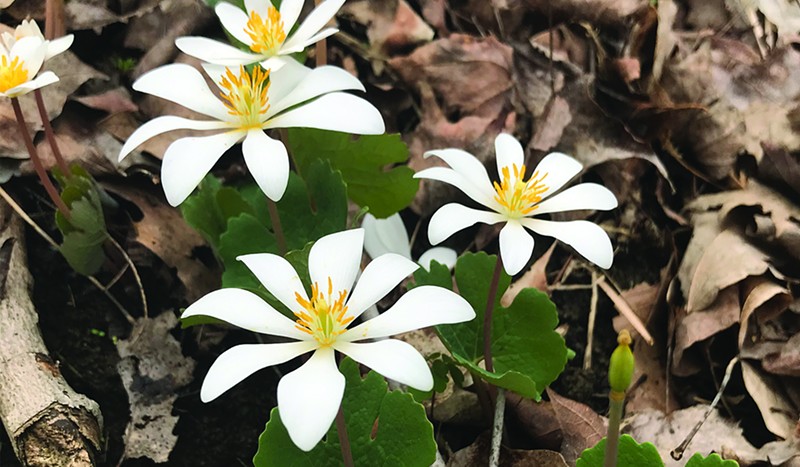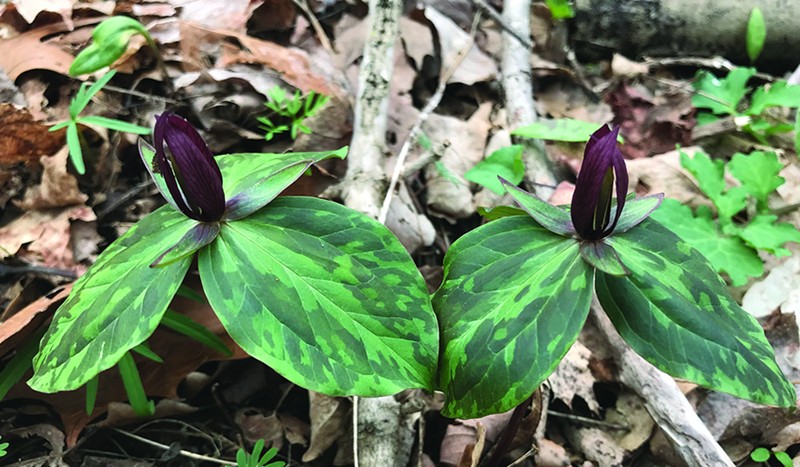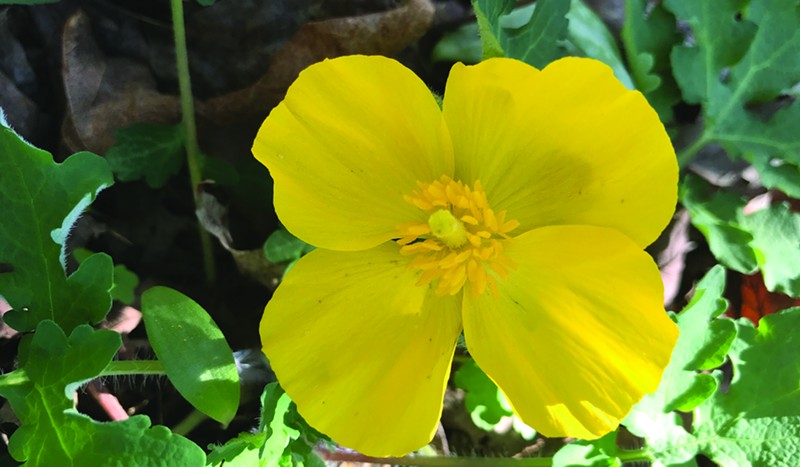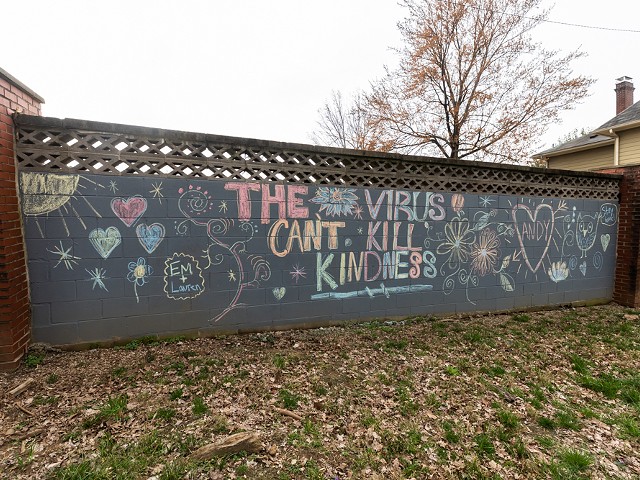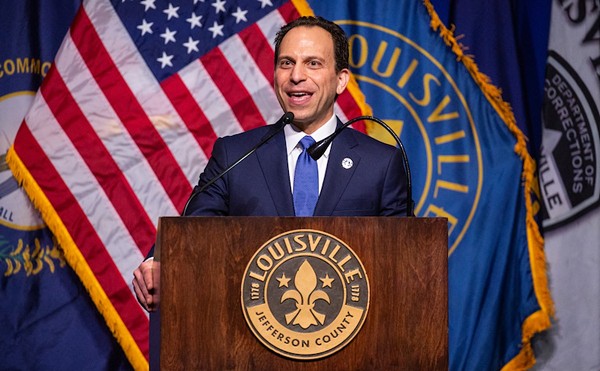A startling irony of the novel coronavirus, both its emergence and the ensuing self-isolating that we’ve assumed, has been the fact that its spread has paralleled the increase of spring. While the economy has largely ground to a halt, and while the attendant unease, disorientation and fear has grown from the crisis, the world outside our windows displays its fecundity. Whether we can safely take comfort in nature, or even if we should, is the question we must ask of ourselves.
In mid-February, with the first wave of warm weather and several weeks before the country as a whole came to appreciate, and react to, the spread of the virus, I went for a walk in the woods.
I drove south to the Knobs State Forest, a place I had not been before but had wanted to explore. I drove along Crooked Creek to a trailhead that lay on the other side of the stream with no bridge to access it. Given the high water, and the fact of my driving a small hybrid, crossing was impossible, and so I turned around and followed the road back to another trailhead within earshot of the interstate.
I set out in a southerly direction with my camera along a route paralleling a stretch of power lines. The path, more or less an access road, was thick with deep mud, and for a moment, discouraged, I considered turning around but did not. I followed signs, turning east into a forest that seemed razed. Cut trunks and limbs were piled haphazardly along the steepening trail that utilized an old two-track road.
At the peak of this first hill, I crossed under another set of power lines and paused to look over some patches of ice glazing some ruts in the trail. Around me were the knobs, rising as high as 800 feet, the trees bare. I could hear the traffic, but as I continued eastward and downhill into the undisturbed woods, the roar of the freeway gave way to silence. At once, I was immersed in what I think of as the natural world, despite the few signs of human enterprise — the roadway, the logging, the occasional bits of trash.
At the bottom of a ravine, I found a creek that is, to my knowledge, nameless. Water from days of rain tumbled over small falls, the music of it mesmerizing. Along a cutbank, a loop of tree roots formed a perfect seat. I sat and listened to the water a long time. As I sat still, I began to see birds flitting high in the trees, undisturbed, I imagined, by my presence.
The day proved bright with sunshine, warm enough for me to tie my fleece about my waist. I wandered these woods for the afternoon so that when I reemerged, I was refreshed. I could return home and carry the place with me, what it meant to me. I thought that the small space of the creek I’d found, with its seat among the rootstock, was a fine metaphor for my heart. I envisioned the walk this way: I’d found myself, the heart of the forest mirroring the core of my being.
One evening, watching Kentucky’s governor speak about traveling during the pandemic, I thought about this place. I set the phone on a shelf to watch him speak as I made dinner. I’d just returned from a day in Mammoth Cave National Park, where services — the visitor center, cave tours, the store and campgrounds — are closed indefinitely, in response to the guidance established by the Centers for Disease Control and Prevention. The surface trails, however, remain open.
Gov. Andy Beshear, for his part, does not insist that we stay entirely in our homes. He cites the fact that taking walks, whether in parks or in larger natural areas, is emotionally healthy. He does insist, however, on maintaining social distancing in the places we visit. A question that has confounded me has been to what extent I, and we, might have an experience with nature during a crisis, if only to give relief from our self-quarantining, but at the same time to maintain our safety and, perhaps more importantly, to fulfill our obligations to one another.
Yet, I have even managed to find solitude there As recently as March 16, Bernheim Arboretum and Research Forest remained open to the public, though its visitor center was closed, its events canceled. Bernheim’s more than 16,000 acres, an email newsletter suggested, left “plenty of room for social distancing,” and visitors were encouraged to “take advantage of the health benefits nature can provide.” When I read this, I understood the sentiments.
Yet it came as no surprise when, only 10 days later, Bernheim closed to the public, citing concern for the health of not only its visitors but its staff and volunteers. By March 27, the U.S. Forest Service suspended all public access and backcountry camping in the Red River Gorge, and only a few days later, Powell County released an executive order that effectively closed all trails on state lands and state parks in the county, including Natural Bridge State Park. Reactions to the news, at least those one might see on social media, varied.
That region, encompassing what we’ve come to know as “The Gorge” is a prominent destination for people from not only Louisville but the state as a whole — and other states, too, especially Ohio. The all-volunteer trail crew in the Red River Gorge has likewise suspended their efforts. The area is being patrolled. To date, most state parks are limited to hiking between 7 a.m. and 7 p.m., and Cumberland Gap National Historic Park is completely closed to the public.
To be outdoors, to make space for ourselves in the sunlight and find solace, especially with the onset of flowering magnolias and redbuds or the dearth of wildflowers erupting on the forest floors, most of us have no choice but to visit the parks of Louisville. Cherokee Park, which is extensively frequented anyway, has been busy with walkers, especially on the paved loop.
Though Louisville Parks and Recreation closed all playgrounds, picnic shelters, community centers, dog parks, basketball courts and soccer fields, the parks themselves, at least their open spaces and trails, remain open, though users are expected, and required, to follow the guidelines of social distancing. I have visited Cherokee Park a few times with my daughter, but we have avoided the road, heading instead for the trails.
The Parklands of Floyds Fork, which I have also visited over the course of several warm days, is likewise exceedingly busy. As with Cherokee Park, the paved paths in the Parklands — and I have been mostly to the Broad Run and Turkey Run units of the park — are a steady pulse of walkers, bikers, and baby strollers. I have opted, again, for the remoter trails. I have even managed to find solitude there.
The walk was a relief On one particular day, on a dirt path through a gorge along Floyds Fork, I found myself on a stretch of perhaps no more than 50 yards, among teeming crowds of wildflowers. Twin leaf and bitterroot; yellow fawn-lily, which I knew from growing up in New York State as dogtooth violet or trout lily; five-lobed toothwort and spring beauty; toadshade trillium; the celandine poppy, also known as the “wood poppy,” its bright yellow petals fed on calcareous rock — limestone, in the Kentucky country. I was astounded.
I did not see many people along the trail, and I am hesitant to even admit its location. I talked to one woman, who kneeled before a patch of fawn lily growing along a thin creek. She was photographing the nodding blooms, their speckled petals nearly inconspicuous, with a macro lens. We talked a few moments about the cycle of Kentucky’s flowers. We kept our distance from each other, respectfully. In the creek, at even the quietest approach, frogs, already fully grown, leaped into the pools and vanished immediately beneath piles of silted leaves. The walk was a relief.
For the most part, we were alone A few days later, I took my daughter to see those flowers. Later, we hiked a short trail down to a narrow creek that fed into Turkey Run. She played among the rocks while I sat and listened, quietly, to the water spilling over cobbles of limestone. A few flies hovered in the air, and water striders glided over occasional pools. The temperature, on this late-March day, hovered in the seventies. At one point, we heard a shuffling of leaves among some cobbles in the creek and, peering into the detritus, saw a nearly opaque crayfish squirming between the stones.
We followed the creek downstream to its confluence with the far larger stream of Turkey Run. My daughter fingered the moss, bright on the wet rocks. We found fossils of brachiopods on the shores. What people we saw were high above us, either walking the paved path or closer but still at a distance, along the dirt trails. For the most part, we were alone.
I have sought out these isolated places more in the ensuing days. The Jefferson Memorial Forest, which remains open, is actually fairly large, at 6,500 acres. Along the Siltstone Trail — again, I am reluctant to describe our whereabouts too exactly — we found another nameless creek to sit by. My daughter played, I made photographs. We climbed to a knob where redbuds, serviceberries, and dogwoods were all in bloom. We could see, given the lack of leaves in the big oaks and hickories, the tips of ridgelines across the ravine.
By the end of the weekend, my daughter and I both admitted that these short trips into the woods — whether in Cherokee Park, Turkey Run Park, or the Jefferson Memorial Forest — were among our most enjoyable times together. The change of pace from being in the house was essential, and especially for me, being restless by nature. Restless for nature, truth be told. Though we have plenty to read, a Netflix account to draw on, and games to play together, we need movement, exercise.
Change in the neighborhood At this point in the pandemic, we have not been told to stay within our homes, neither by the federal or state government. We are not required to shelter-in-place, though experts contend that the investment of such quarantining, if only for two weeks, can have a major impact on the length and severity of the outbreak. At the very least, my neighbors in Schnitzelburg walk our shared streets. People walk dogs or stroll with their children. I have seen many couples smiling and laughing together, and I admit I find it lovely.
I have, in fact, seen a change in the neighborhood. I’ve lately contended that, for as long as I can remember, people have spent their days at work and gone home only to disappear inside, perhaps to watch television or search the internet, or otherwise be with families. I would see a few people walking in the evenings, and, of course, people would sit on their porches.
But it is different now that people are home all day. In the evenings, they instead come out. I have lately greeted — always at a distance — my neighbors, many of whom I have never seen. I have noticed, too, a friendliness. Surely, we are all feeling the same air, heavy with spring. We see the redbuds crackling along the street, the dogwoods beginning to open. Tulips sprout, and the birds sing throughout the day. Squirrels fashion their nests, possums shuffle about by night. We all feel, too, the same fear. Even the same allegiance.
The nature that is us On a warm day, I drove to Mammoth Cave National Park, an hour-and-a-half south. What people were there, and there were not many, were most likely locals. The only people I talked to were two men out looking for mushrooms. The visitor center parking lot, where I’d gone in hopes of finding a map, was empty but for a few cars. There was no one to be seen. The only sound was wind in the trees. The store was closed, the campground empty.
I found a hollow I hiked into. The limestone cliffs were green with moss and ferns, the forest floor a continuous flower garden with many of the flowers I’d already seen and more — Dutchman’s breeches, Solomon’s seal, and the rare nodding trillium. The place was Edenic. Later, I wandered among a series of massive sinkholes and came to an overlook of the Green River. A few people were about, hunting for morels, but largely the woods were vacant.
The governor has said, go for a drive, but stay in your car. Or, if insistent on going for a walk, or a run, maintain social distance. There will be arguments against even this, regardless. New research has emerged demonstrating that infected droplets from our breath can hang, in unventilated rooms, for upwards of 20 minutes. Those droplets can come not only from coughing, the research showed, but from an animated conversation — from speaking loudly.
So, it may be that, finally, to truly put the pandemic behind us, or at least this surge of it, we will need to stay at home for an extended period of time, avoiding any public place including the parks, the wildernesses. Given that, we can acknowledge and live within, for a time, for what could be as little as two weeks of absolute quarantining, the nature that is close to us and, finally, the nature that is us.
From my porch, far from the sidewalk, I watch the birds in the sugar maple and in the euonymus: song sparrows, cardinals, blue jays, wrens, house finches, the occasional downy woodpecker. I see the ginkgo leafing, the lavender sprouting, the azaleas nearing blossom. Further, I see the clouds and spend time learning to identify them. I feel, always, the circulating air. In the backyard, in a shaded corner near the fence, my rue anemone, given to me as a gift several years ago, has once again bloomed.
In this time, we can accept the invitation to be with ourselves, for we are as much nature as these birds, these trees, this air. Our books, or even a film we watch, might act as field guides to the paths within ourselves. There are many dark forests in us that want for exploring. I have chosen to do that. I believe that when we reemerge from our homes, we will carry something we have found within the forests of ourselves, within our own coves and hollows, that will allow us to experience, at last, the world we constitute as “nature” in an entirely new and profound way.


